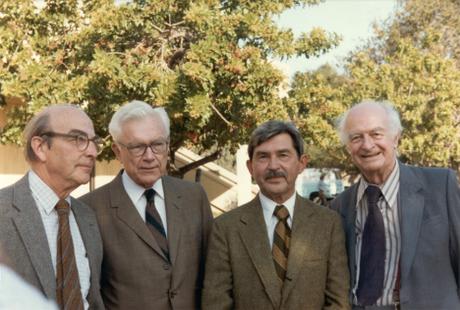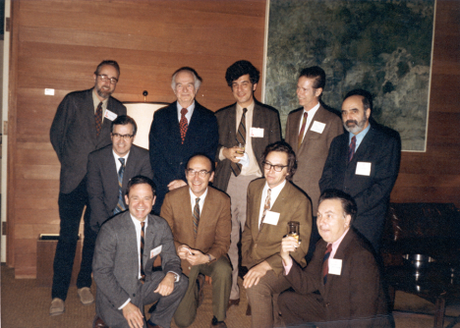
Four Nobel Prize-winning chemists with a connection to Stanford University. From left, Arthur Kornberg, Paul Flory, Henry Taube, and Linus Pauling. This photo was taken in 1983 on the day that Taube received notification of his awarding of the Nobel Prize in Chemistry.
[An examination of Linus Pauling’s years at Stanford University, part 3 of 7.]
From the outset, Linus Pauling knew that his time at Stanford as a full professor would be short-lived. Hesitant from the beginning, Stanford had stipulated that Pauling’s contract go up for renewal every year and that his reappointment hinge on his effective supervision of research. Furthermore, during his second year in Palo Alto, beginning fall 1970, Pauling’s salary was reduced by about half.
In fall 1971, at the start of Pauling’s third year, Harden McConnell – a distinguished chemist at Stanford and a close friend of Pauling – defended Pauling’s right to remain a full professor even though he had arrived at the university’s mandatory retirement age of 70. In making his argument, McConnell wrote that no current professor “should have an automatic right to office and/or laboratory space after standard retirement age, nor should any outstanding and active scientist be denied such space merely because of age.” McConnell further suggested that he could easily prove that Pauling fell squarely into the latter category.
In fall 1972, though Pauling’s research activity had remained undeniably high, William F. Miller, Stanford’s Vice President and Provost, informed the Associate Dean of the School of Humanities and Sciences, Calvin Quate, that he thought it “unwise to approve further reappointments of Dr. Pauling as a regular Professor” and suggested that Pauling be appointed Professor Emeritus beginning in September 1973. In other words, Pauling would be allowed just one more year as a full professor.
As it turned out, Pauling would receive an additional year beyond Miller’s recommendation. This information was formally communicated in a November 1973 letter written by Henry Taube, at the time the chair of the chemistry department. In it he wrote, “Your colleagues in this department hold you and your work in very high esteem and place great value on your continued association with this department.” Taube also told Pauling that when he became Professor Emeritus in fall 1974, he could continue his research contacts with graduate students, though an active professor would need to serve as a “nominal sponsor.” Taube also told Pauling that he could be called back as a full professor at any time.
In fairness, Pauling had begun to retreat from active participation in academic life at Stanford at least a couple of years prior to Taube’s letter. During winter term 1971 he taught his last course, a special topics class on the structure of atomic nuclei. By then, the only real notes that he needed to conduct the course were sets of equations that had been worked out step-by-step in advance.
Pauling also served on the Academic Senate while at Stanford, a stint that lasted for two years and that also came to a conclusion in 1971. In submitting his resignation that spring, Pauling told H. Donald Winbigler, Stanford’s Academic Secretary, that “decisions about the University should be made by younger men who can look forward to a longer period of association with the University.”
As his connections lessened, Stanford’s support withered accordingly. By fall 1972, Pauling was no longer receiving a Stanford salary; only office and laboratory space. As such, his sole form of professional funding was, by this point, coming by way of outside grants that he had been awarded.

Pauling with other members of the Stanford faculty, 1973. Back Row, (l. to r.) Norman Wessells, Eric Shooter, Pauling, Peter Ramwell, John Luetscher, Jr., Luigi Luzzatti; Front Row (l. to r.): Edward Rubenstein, Arthur Kornberg, Robert Schimke, Robert Hofstadter. Pauling, Kornberg and Hofstadter were all recipients of Nobel Prizes.
In August 1974, Pauling retired from Stanford and formally became Professor Emeritus of Chemistry. But even in this capacity he maintained a connection with the university and his former department. Perhaps most notably, Pauling continued to sit on graduate student committees and steadfastly updated his still-growing list of publications for inclusion in department pamphlets.
After his retirement, colleagues at Stanford also continued to seek out Pauling, often inquiring about the progression of his research. Stanford Magazine likewise profiled Pauling in 1979, some five years after he had left, asking him to reflect on his career and his engagement with the world. In the piece, he explained his approach to life, which had remained remarkably consistent over the years.
I have a sort of general theory of the universe. I try to fit everything I read into the general picture. If I read something that doesn’t fit, I wonder about it. Or, if I think something seems to fit, I try to follow through.
He also reflected on the varying degrees of satisfaction that he had derived from his work as a scientist and peace advocate: “With the Chemistry Prize, I was just enjoying myself, learning about the nature of the world,” Pauling explained, “having a good time and making a living, too, as a professor… The Peace Prize came for work that I was doing as a sacrifice… I was taking time away from the things I really like to do, but doing it because of a sense of duty.”
Pauling maintained a residence on the Stanford campus and, by 1984, he was still delivering guest lectures for courses taught at the university. One of these was for an Optimal Health and Fitness course taught by Dr. Jack Martin. Following Pauling’s appearance, Martin shared some of the student feedback that he had received concerning their guest lecturer. The comments covered a range of impressions including: “smart guy but not very interesting”; “vehement and extremely knowledgeable, not to mention amusing”; “entertaining, but a grain of salt is necessary”; “it is always great to hear from someone as famous as he”; “new stuff, good presentation”; “a little weird”; and “incredible man.”
As late as spring 1993, Pauling remained on call to represent Stanford on occasion. In one instance, he participated in a meeting with the Swedish Minister of Education and Science, Per Unckel, who was visiting to explore a potential research collaboration on environmental problems. Associate Dean of Research Patricia Devaney had asked Pauling to meet with Unckel during his visit and Pauling, then 92 years old, obliged.
In the years following his passing, Pauling remained of interest to the Stanford community. An undergraduate student, Kristine Yu, wrote about Pauling for the spring 2003 issue of The Stanford Scientific, basing her article on press releases and conversations with those who had known him.
One anecdote concerned a visit that Pauling had made to Henry Taube’s home. The story had it that Pauling was interested in an “unusual” geode that Taube had brought back from Brazil. As Pauling looked at the specimen, Taube shared his personal theory of how it had been formed. Pauling responded, “If you feel that strongly about it, you should write a paper on it.” Not long afterwards, Pauling sent Taube a long letter explaining how Taube’s theory was wrong.
Advertisements